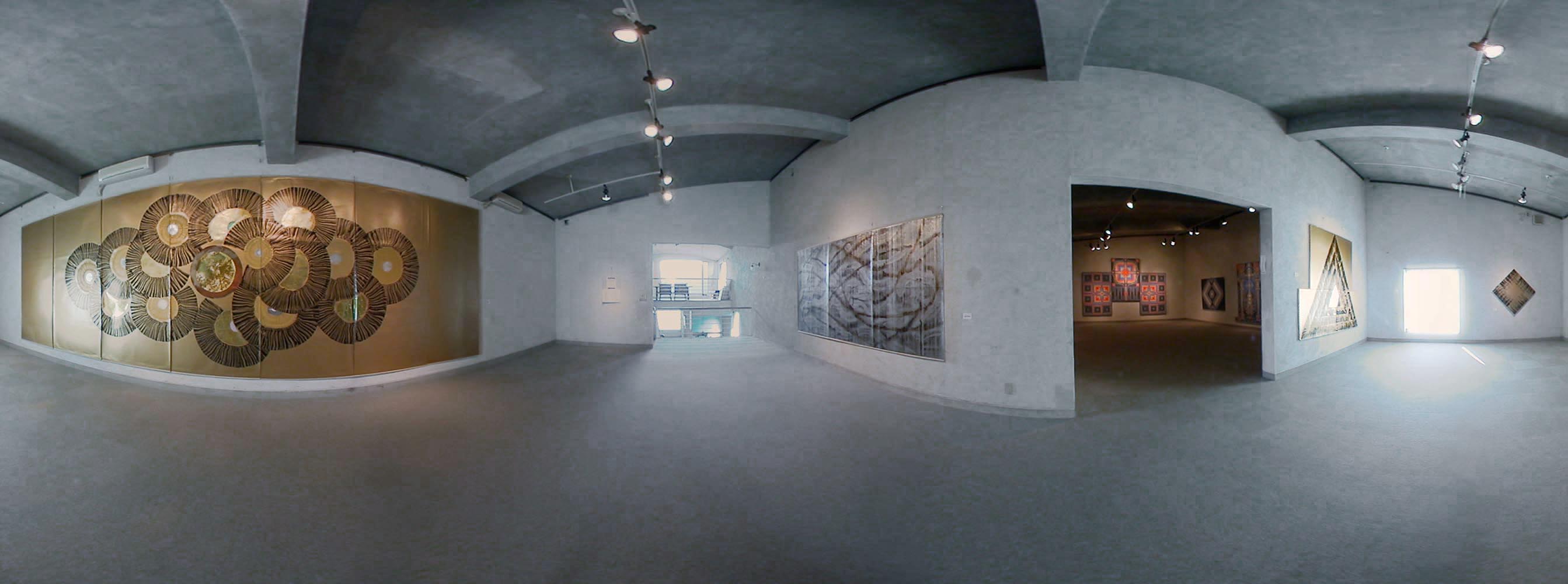



















「世界の中の日本美」
今までの近代西欧の人間中心主義が行き詰まり、新たな方向として自然界との共存があるとすると、芸術も個としての絶対的な限界のある人間意識ではなく、人知を超えた自然、あるいは宇宙の中に存在する人間という新たな広い視点を持たなくてはならないだろう。平松にとってのコンセプチュアルアートとはこのような宇宙観でありスピリチュアルアートなのであった。
そもそも絵というものは、たとえば花の絵であれば、その花の一瞬の美を永遺に残したい固定したいという一つの人間の欲望に根ざしている。西洋美術は物そのものを描こうとするが、日本の美術は、その存在する全体的な「場」を重要視し表現する。場とは空間であり物は単に存在するのではなく場の中に存在するのである。
日本の美術において、余白が重要とされるが、余白は「場」をあらわすからである。平松にとって四角の絵とは、その中に自然や宇宙を表現することに他ならなかった。
彼女の作品は、色彩豊かなアメリカ時代、白のドイツ時代、黒の日本の時代、さらに晩年には最終形として金色と銀色の時代に移っていった。それは世界で一番美しいカラフルな作品、世界で一番美しい白の作品、世界で一番美しい黒の作品をめざしたからだ。最後に、金、銀のシリーズで、日本の「わび・さび」と「雅」は一つとなった。
かつての伝統芸術は類型化し図案化して進歩がなくなった。図案化とはイラストレーションであるがゆえに、無作為を基本とするわびさびとは正反対である。一方、現代美術も何を描いたらよいのかわからなくなり停滞した。美術とは美しさを目指すことであり、芸術家はそれぞれ自分の美を開発しなくてはならない。
彼女の師である坂田一男の教えは、芸術はとどまることなく前進しなくてはならないということだった。
平松は日本の伝統的な墨や和紙を使っただけで伝統的などと主張したり、奇抜さや目新しさだけで安直に前衛などと言ったりはしない。誰もしたことのない技法を開発したのは開発が目的ではなく、既存の手法では新たな美を表現できなかったからだ。
日本の伝統美術は輝子によって、抽象化されると同時に比類ない美しさ、ダイナミックさが備わり新しいものに生まれ変わった。平松は世界各地を旅するごとに自分の中の「日本」を発見することになった。多くの識者が日本的な美意識に立った現代美術の到来を期待し望んだ。その現代美術は平松輝子により実現された。
「二紀和太留の本名は平松和太留であるが、略すると平和である。この美術館の開設の契機として戦争と平和がある。二紀は1921年に熊本で生まれ,1943年に海軍に入隊し、戦艦榛名に乗船しマリアナ沖海戦、レイテ沖海戦に参戦しながら奇跡的に生還した。
しかし、これらの戦いで多くの戦友が亡くなった。そして戦後、彼らのことを一生、気にかけながら作品を描いた。作品に表れる輝くような光は彼等にたいする鎮魂の意味がある。
この美術館では奥の展示室に巾4mの作品「天の光マンダラ」を常設展示しているが、この部屋に入ると、「異次元に来たようだ」と多くの方が言われる。来館者の感想文の一つを紹介する。
「この平和な時代の陰に多くの方々の貴い命が失われていった事を思うと、いつも、いつも、8月15日に深い反省の念を思い起こします。戦争を知らない世代と残り少なくなった戦争経験世代と、もっといつまでも話をして、二度と繰返さない努力をしていかなければならないと思います」
“The Japanese beauty in the world”
Assuming that human-centeredness centrism in contemporary western Europe
is at a dead end and assuming that some seek to share a renewed existence
with the natural world, art must be broadly considered in terms of nature
and in terms of human existence in the universe, both concepts beyond human
understanding, and liberated from the confines of human consciousness.
For Hiramatsu conceptual art is such an outlook on the universe and the
spiritual.
In her flower images,the artist wanted to express its beauty and to secure
its ephemeral image into the future. While Western artists tend to draw
a thing as itself,Japanese artists consider the importance of its “place”.
It belongs to space, and the object fills this place rather than exist
as itself.
In Japanese fine arts, unfilled space is considered important because
unfilled space expresses “Place”. To Hiramatsu the square canvas presented
a drawing place for nature and the universe. Hiramatsu's work moved from
rich color in her U.S. period, to white in her German period,black in her
Japan period, and finally silver and gold in her old age. She sought the
most beautiful hues in the world, the most beautiful white in the world,and
the most beautiful black in the world respectively.
Japanese “Wabi”,” Sabi”, and” Miyabi” became united in her final series
of gold and silver.
Traditional art trend toward stereotyping, and stall in their advancement.
Stereotyped form is one area of illustration, while Wabi-Sabi based randomized
design is an opposite concept. It can be said that modern art has stagnated
through loss of the goal of artistic creation. An aim of art is beauty.
Each artist has to develop his/her own peculiar beauty.
Kazuo Sakata's guiding precept was that art should advance ceaselessly.
Hiramatsu does not claim that because she uses traditional Japanese Sumi
and traditional Japanese paper her art is traditionally Japanese, nor does
she insist that because it has novelty her art is avant-9arde.0nly because
she could not find expression in existing techniques, did she create novel
new technique.
The Japanese traditional arts were given abstraction, equipped with beauty
and dynamism, and recreated anew by Hiramatsu. Whenever Hiramatsu traveled
the world, she discovered the “Japan” inside her. Many intellectuals desired
the arrival of a contemporary art which could revive Japan's aesthetic
sense. Hiramatsu realized that wish.
-
展覧会には空間構成を含み作者を含む展覧会関係者の思いがこもっています。できればこのまま永遠に展示を続けたい展覧会もありますが残念ながら展覧会は期間があります。そこで、これらの思いを少しでも忠実に再現するため、360度パノラマのCyberMuseumが生まれました。展覧会の記録を半永久的に保存した新たなインターネット上の美術館をお楽しみください。
3 平松輝子 Teruko Hiramatsu/「水の波動」 ”The Water wave motion” /金銀紙、Gold & silver Paper
5 平松輝子Teruko Hiramatsu/「宇宙2、「太陽の光の金色と月の光の銀色という光り輝く世界」”Universe2、 “Sunlight,Gold and Moonlight Silver, Shining World”
/金銀紙、Gold & silver Paper6 平松輝子Teruko Hiramatsu「禅1-清浄主義、禅」/” Zen1、white purism、Zen”/ 墨、Sumi
7 平松輝子Teruko Hiramatsu /「禅2-清浄主義、滔々」、” Zen1、white purism、Toutou”
/ 墨、Sumi9 平松輝子Teruko Hiramatsu/「禅4-黒の精神世界 ほとばしる」”Spiritual black sumi world、
The stream.”」/墨、Sumi11 平松輝子Teruko Hiramatsu /「禅6-黒の精神世界 石と水」”Spiritual black sumi world、
The rock and water1”」/墨、Sum13 平松輝子Teruko Hiramatsu /「古代文明シリーズ1-ギリシャ」”Ancient civilization1、Ancient Greece”/ 墨、和紙、Sumi、Washi
15 平松輝子 Teruko Hiramatsu/「自然の終焉」” The end of the nature” /アクリルAcrylic
1 二紀和太留Wataru Fuki
4 二紀和太留Wataru Fuki
3 二紀和太留Wataru Fuki
CyberMuseumの続きを観る click here2 二紀和太留Wataru Fuki
16 平松輝子Teruko Hiramatsu/「1960年代のミクストメディア」”A mixed media in1960’s “
/ Mixed media 墨セメント和紙14 平松輝子Teruko Hiramatsu/「古代文明シリーズ2-エジプト”Ancient civilization2、Ancient Egypt” / 墨、和紙、Sumi、Washi
12 平松輝子Teruko Hiramatsu /「禅7-黒の精神世界 石と水」”Spiritual black sumi world、
The rock and water”」墨、Sumi10 平松輝子Teruko Hiramatsu/「禅5-黒の精神世界、白龍」”Spiritual black sumi world、White dragon”」/墨、Sumi
8 平松輝子Teruko Hiramatsu/「禅3-黒の精神世界」”Spiritual black sumi world” Japan」/墨、Sumi
1 平松輝子Teruko Hiramatsu /「みやび1」/ 10,000の石の雨、“Miyabi 1-The rain of 10,000 stones”/ アクリル和紙Acrylics Wash
2 平松輝子Teruko Hiramatsu /「みやび2」/ “Miyabi 2- The elegant Japan” /アクリル和紙Acrylics Washi
1 平松輝子の世界
2 二紀和太留の世界
4 平松輝子Teruko Hiramatsu/「宇宙1、「太陽の光の金色と月の光の銀色という光り輝く世界」”Universe1、 “Sunlight,Gold and Moonlight Silver, Shining World” /金銀紙、Gold & silver Paper
